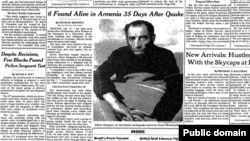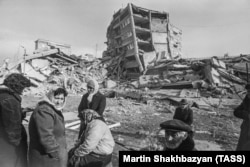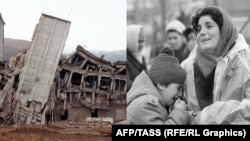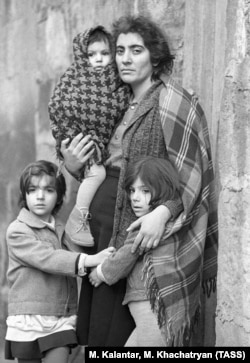Buried in a cold basement under tons of crumbled Soviet concrete after a devastating earthquake, six Armenian men ate jarred pickles and canned fruit for 35 days before being miraculously rescued on a wintry day in January 1989.
Seemingly disoriented 50-year-old electrician Haikaz Hakopian was shown on a hospital bed in the Armenian capital, Yerevan, telling the men's amazing tale of underground survival -- the longest anyone had ever spent beneath earthquake rubble and lived to tell about it.
"I remember I was in the cellar with my neighbors and then dishes started breaking," Hakopian recounted. "I remember we tried to get up. I don't remember much after that."
He added that he had sung songs and told tales to help keep the other five men entertained during their ordeal, dubbed by Soviet news agency TASS the "Leninakan miracle," after the city where it all happened.
Hakopian and the others' saga reverberated throughout the Soviet Union and beyond, and was quickly picked up by foreign media outlets, including The New York Times.
It was an inspirational story of human hope and survival, but there was one problem: It was a hoax.
An early instance of fake news, Soviet-style.
The tragedy itself had been all too real. The temblor that struck northern Armenia on December 7, 1988, killed more than 25,000 people, injured up to 130,000, and left hundreds of thousands homeless or without basic supplies.
But exactly two weeks later, a Libyan bomb blew up Pan Am Flight 103 over Lockerbie, Scotland, killing all 259 people aboard and 11 more on the ground. That brutal terrorist attack snatched the global spotlight from Armenia and vast swaths of the international community seemingly forgot about the plight of the earthquake's victims.
That's when Artyom Shahbazian, a reporter for Soviet Armenia's Armenpress news agency, decided to fabricate a remarkable story to refocus global attention on Soviet Armenia's horrific tragedy, three of his former colleagues tell RFE/RL.
Shahbazian -- who emigrated to Israel after the break-up of the Soviet Union and who died in Canada in 2005 -- was convinced that his countrymen needed his help, they said.
"Western countries had already begun to forget about it," Lyova Azroyan, a longtime Armenpress reporter based in Yerevan, tells RFE/RL. "That's why [he said he] invented the story."
Shahbazian sent his bogus story of the rescue to TASS so that it would get international distribution, according to Azroyan.
Another account suggests that a TASS reporter was with Shahbazian in Leninakan and conspired to make up the report.
But Aram Ananian, the current director of Armenpress, tells RFE/RL he knows that Shahbazian was the author.
PHOTO GALLERY: On December 7, 1988, an earthquake shattered the north of Soviet Armenia. Three decades later, the region is yet to recover from a disaster that killed more than 25,000 people and destroyed tens of thousands of homes.
An Even Bigger Hoax
Another Armenpress journalist at the time, Armen Dulian, concurs that the rescue hoax was Shahbazian's work. He also acknowledges to RFE/RL that he wrote even more of a whopper in the quake's aftermath.
But the fake story by Dulian, who subsequently worked for RFE/RL and remains a popular fixture on Armenian Public Television, appears to have been quickly spotted as a hoax. In it, he wrote that several pregnant women in the earthquake zone had given birth to babies with superhuman abilities like night vision and fur, presumably due to the cold conditions their mothers had been subjected to.
Dulian said he also wrote his "superbaby" tale in hopes of highlighting the poor conditions his compatriots were enduring since the initial tragedy. "I wanted to draw the attention of the world to our misfortune," Dulian told RFE/RL in the run-up to the 30th anniversary of the Armenian earthquake. "That's why I invented the story. I didn't expect that the world could perceive it as a true story. It was a mistake that I never repeated in my journalistic career."
Although Dulian's ridiculous, U.S. tabloid-like story about freakish babies was probably laughed at by most readers, he said some media outlets actually believed it and that a German TV crew called him to come to Armenia to film the unusual babies. He had to tell them the story was a hoax.
Real People
Shahbazian's equally fictional story of the pickle-eating Hakopian's rescue was seemingly more believable.
Despite countless stories after earthquakes around the world in which survivors exaggerate or mistakenly recount the amount of time they spent under rubble before their rescue, Shahbazian's story seemed plausible -- particularly after Hakopian appeared on Soviet TV talking about his ordeal.
Although Shahbazian seems to have taken the details of his ruse with him to the grave, Hakopian was a real person who seemingly survived the earthquake.
A TV report on the U.S.S.R.'s popular Vremya news program claimed Hakopian was brought to Yerevan from the stricken city of Leninakan (which is today known as Gyumri).
Dulian says Shahbazian had gone to Leninakan and may have met Hakopian there. Whether those two concocted the story together or Shahbazian simply embellished Hakopian's original account of a rescue is unclear.
Some reports -- excluding the fake one -- stated that Hakopian's wife and four children had been killed in the tragedy. A doctor was even on hand for the television report to say that Hakopian's condition was satisfactory.
The other five men were reportedly not brought to Yerevan for treatment -- only Hakopian.
New Transparency, Exposing Lies
It didn't take long for Soviet officials to begin to doubt the authenticity of the January 13, 1989, TASS report about the six miracle survivors.
The next day, The New York Times reported that Soviet media had "cast doubt" on the report of the miraculous January 11 rescue. TASS reported that it could "neither confirm or deny" the account, and Armenian officials told The New York Times that its branch of the Soviet Health Ministry was trying to "verify the facts and find all of" the six purported survivors.
The New York Times expressed hope that its story of the rescue "might yet turn out to be true" and offered a sliver of praise to the openness in the media brought on by Mikhail Gorbachev's rise to power in the Soviet Union.
It noted that Gorbachev had "brought not only a new liveliness but also a new element of uncertainty into [the Soviet media and] what used to be a monolithic propaganda machine, one that was counted on for consistency, if not always truth."
The central Soviet newspaper Izvestia announced it had been unable to find any of the other men cited by Hakopian as having been rescued and had launched an investigation into the "Leninakan miracle."
Hakopian was even said to have been given a psychiatric evaluation and found to be "completely normal." Though a TV report said he acted "exhausted and distracted" during an interview, casting doubt on the accuracy of some of the quotations attributed to him by TASS."
But a day later the charade was seemingly over.
The New York Times printed a story titled Soviets Say Armenian Invented Ordeal In Quake, with TASS reporting that Hakopian and his sister seemed to have made up the story about being trapped for 35 days under the rubble.
More recently, in the weeks ahead of the 30th anniversary of the Armenian tragedy, efforts by RFE/RL -- including pleas on a local Gyumri TV station and social media -- to locate Hakopian or any of the other men named in the bogus rescue report were unsuccessful.
Sergei Nazaretian, an adviser to the director of the Armenian National Service for Seismic Protection, tells RFE/RL that the last recorded rescue after the 1988 earthquake was the discovery of a victim 13 days later.
It will likely never be known if Hakopian and Shahbazian knew each other or collaborated in some way on the fake story.
It's also difficult to know whether Shahbazian's fake news story succeeded in getting the world to pay more attention to the horrible predicament the Armenian people were in.
What is certain is that even 30 years later, many of the cities in northern Armenia hit hardest by the earthquake are still struggling.













